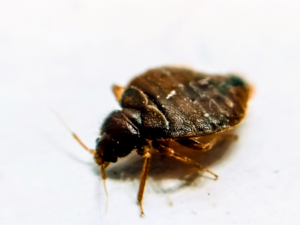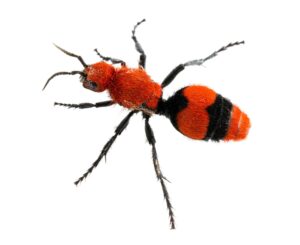Home / Blog / What Do Tick Bites Look Like?
What Do Tick Bites Look Like?

Scientifically reviewed by Daniel Baldwin, BCE, CCFS, CP-FS
-Published on September 28, 2024
-Updated on October 20, 2025
Whether you’re hiking in the woods, mowing the lawn, letting your dog play outside, or just spending time outdoors in the warm weather, it’s important to know how to spot a tick and its bite. Removing a tick as quickly as possible is even more important because certain diseases are passed from infected ticks to humans and animals, causing illnesses such as Lyme disease and Rocky Mountain spotted fever.
To protect yourself, your family, and your pets from tick-borne diseases, learn more about what ticks look like, how to remove them from the skin, and effective ways to prevent tick bites in the future.
How to Spot a Tick
What Do Ticks Look Like?
The most common of these parasites are the black-legged deer tick, the American dog (wood) tick, and the Lone Star tick. Each is a spider-like arachnid that has eight legs. Their oval-shaped body is usually reddish-brown, black, brown, or gray, depending on the tick you’re looking at. The Lone Star tick below is more reddish, while the deer tick is black with a brown or red backside.
What Do Tick Bites Look Like?
Tick bites can vary in appearance, but they often start as small, red, and itchy bumps. Tick bites on skin may sometimes develop into a rash or a small, dark spot at the center if the tick is embedded for a longer period.

The tick bite wound might also show signs of irritation or swelling. In some cases, a tick bug bite can cause a characteristic “bull’s-eye” rash, especially in Lyme disease cases. It’s important to monitor the bite area for any changes or symptoms, as early detection can help in managing potential diseases.

What Do Ticks Look Like on Humans?
When ticks attach to humans, they are small and often hard to spot. They usually appear as tiny, flat, and round or oval-shaped insects. Initially, they may be tiny, but they can become engorged and more noticeable as they feed.
How Big Are Ticks?
Ticks are very small, making them difficult to spot. Ticks can live for up to three years if they continue to feed on a host and take in blood. So, depending on the stage a tick is in, it can range in size from what would look like a grain of sand to a poppy seed to a sesame seed.
An adult deer tick measures between 2-4mm, while an adult dog tick is a little larger at 5-6mm. After they feed, they become engorged, which means they are easier to spot because they are bigger, but it may make it harder to identify the type of tick you’re dealing with.
What Places Should I Check for a Tick?
The best way to spot a tick is to perform a thorough body check, especially after time spent outdoors, especially in wooded areas or long grass.
Inspect warm, moist areas of the body where ticks are most likely to bite. For humans, check the armpits, the scalp, the stomach, around the groin, the scalp, behind the knees, inner elbows, and around the ears.
For pets, it’s best to check where there is less hair or fur. Check under your dog’s legs, around the ears, the tail, and the stomach. Don’t forget to check under collars, too. Ticks can be difficult to spot, particularly on long-haired dogs or dogs with dark coats.
After several days, if you don’t spot the tick on yourself or your pet, the critter will fall off on its own. In most cases, there is no danger, but in rare cases, an infected tick may have already transmitted an illness like Lyme disease if it were a carrier.
How to Remove a Tick from a Person
Now that you know how to spot a tick, removing a tick is the next step. Keep in mind that if done incorrectly, you may run the risk of leaving the tick’s mouthparts behind in the skin.
To remove a tick correctly, use a pair of fine-tipped tweezers that has been sanitized in rubbing alcohol. Grab onto the tick with the tweezers, staying as close to your skin surface as possible. Then, pull the tick up, using steady pressure, without twisting or jerking.
Is the insect missing a head? If so, this means its mouthparts are likely still in the skin. Completely remove what’s left of the tick, going a little deeper into the skin using the tweezers.
Be sure to clean the bitten area with rubbing alcohol, soap, and water. Wash your hands and the tweezer, too.
What Do Ticks Look Like on Dogs or Cats?
A tick that is latched onto a dog and has been feeding might look like a raised mole—about the size of a coffee bean. A tick recently attached to your dog may look as small as a poppy seed.
Look for small, black bugs on your pet’s skin that are oval in shape. Upon closer inspection, you should be able to see the eight legs, which is a clear indicator that it’s a tick.

How to Get Rid of Ticks on Dogs
Wear gloves to protect yourself as you get a tick off your dog. Have another person around, if possible, to hold your pet still and keep them calm.
Using fine-pointed tweezers, get as close to your dog’s skin as possible without harming them and grasp the tick. Don’t squeeze or twist the tick; quickly pull it straight up and off your pet’s body. If the insect is missing a head, don’t try to remove it as you would with a tick on a human. Eventually, the tick’s head will fall out on its own. Clean the bite on your dog’s skin.
Drop the parasite into a container of rubbing alcohol to kill it, and hold onto it until you’re sure your dog isn’t showing any symptoms of illness. If so, you can bring the dead tick to your vet for testing.
How to Prevent a Tick Bite
To keep ticks away from you or your pet, avoid walking through brush and tall grass. If that’s not possible, wear long pants, long sleeves, and a hat, then perform thorough skin checks after activities like hiking or spending time in the yard.
Perhaps the best method of preventing ticks is to contact a reliable pest control service that will treat your property for ticks every month. The treatments typically target areas where ticks hide or are most likely to attach to people and pets.
Related Articles
Visit our blog to learn more.
→





